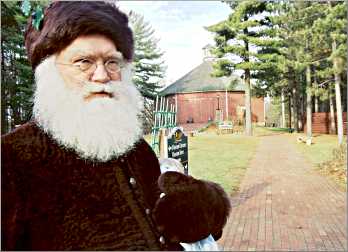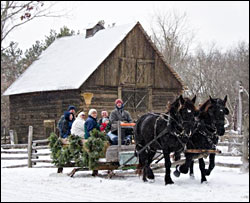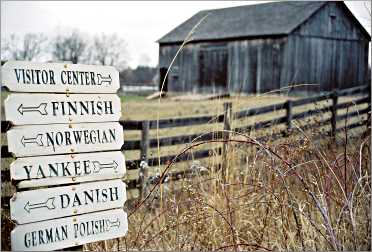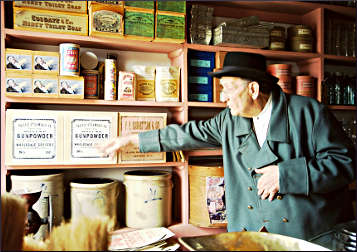In search of Christmas past
At Old World Wisconsin, pioneers party like it's 1899.

© Beth Gauper
Once, every child in America celebrated Christmas without battery-operated toys.
Instead, they played flap jacks and dominos. They made paper ornaments for the tree. They got an orange brought all the way from Florida.
That's still what kids do during Christmas time at Old World Wisconsin, where it's always the 19th century. Danish, Norwegian, German, Polish, Finnish and Yankee families toil there, trying to get ahead on the American frontier.
The buildings, brought in from homesteads all over Wisconsin and reconstructed here, at America's largest outdoor museum of rural life, would be familiar to the real pioneers.
There's a Finnish sauna, an octagonal barn, a stovewood cottage, a schoolhouse and Milwaukee's first Catholic church.
And they'd recognize themselves — at Old World Wisconsin, costumed interpreters portray the real people who lived and worked in the buildings, placed around 576 acres in the middle of Southern Kettle Moraine State Forest.
When we went one December, however, the first character we saw was folkloric, conceived in Europe and brought to life by an American magazine illustrator during the Civil War.
He was a Thomas Nast Santa Claus, with a suit of maroon fur and a henna-colored fur hat with a fur pompon and sprig of holly, an English talisman to guarantee sweet dreams.
"The original color was brown, like bear fur, but on the glass plates they used for illustrations, it came out brownish maroon," said Norm Anderson of Pewaukee, who played Santa.
The pipe-smoking Thomas Nast Santa remained lodged in the national imagination until 1931, when a red-suited, roly-poly Santa was introduced in Coca-Cola advertisements.
Still, with the twinkle in his eye and a curly white beard — both real — Anderson's Santa looked plenty familiar to a little girl named Julianna.
"Are you the real Santa?" she asked. "Can I ask you a quiz question? What's our address?" He'd have to check his address book, Anderson replied, but he was sure she was on his "good" list.
From the yard of the 1897 Clausing Barn, which serves as Old World Wisconsin's restaurant, we walked to the Caldwell Farmer's Club Hall, built in 1874 and 1880 and restored to the year 1900.

© Mike Morbeck
Children were playing with homemade wooden toys and making paper-boat ornaments to honor St. Basil, who travels by boat each Christmas to bring presents to Greek children.
The hall's stage was filled with treasures from Greek-American homes — a mandolin, a bottle of ouzo, a hand-embroidered bedspread, icons of saints, a New Year's vasilopita cake with "1921" spelled out in blanched almonds and a gold coin from St. Basil hidden inside.
Many of the treasures came from the family of Katherine Fafalios of Edgerton, whose grandfathers came to Wisconsin in 1907 and 1915 from villages outside Istanbul; one sent away for a Greek "picture bride" named Katherine, who became her grandmother.
"I didn't realize what a passion I had for this history before I started researching it," said Fafalios, who was at the hall to talk about Greek traditions. "The family ties, the music and dancing, enjoying life — you'll still find them in Greek homes."
Down the road at Harmony Town Hall, a retired professor from Columbia University was in town to visit his daughter and had been asked to recite Clement Moore's "A Visit From St. Nicholas," or " 'Twas the Night Before Christmas."
Clement Moore was an academic, a Biblical scholar and the son of the Columbia University president. For Christmas 1822, he wrote a poem for his children, and the next year his wife sent it to the Troy Sentinel in New York, which published it anonymously in 1823.
"He published lots of things, but nobody remembers anything except the one piece he didn't want published," said Lee Lovas of Hartland, playing the fictional Abraham Perkins, a Columbia professor visiting his daughter Elizabeth in Harmony in 1872.
He passed around a facsimile of the Troy Sentinel of Dec. 23, 1823, with Moore's poem running down the middle of the page in small type.
It was revolutionary, he said, in that St. Nick was depicted as a regular person who rewarded all children, rich and poor: "Suddenly, Christmas could be celebrated by all classes," Lovas said.
Over at the Benson House, we saw how a middle-class Yankee family celebrated Christmas in 1875. On a tabletop, a tree was decorated with strands of popcorn, U.S. flags, walnuts and paper cones; its candles were lit for 10 minutes on Christmas Eve.
The aromas of roasting turkey, stuffing, creamed turnips and potato croquettes wafted from the kitchen, and a bowl of mincemeat was ready for pie — mincemeat as black as tar, made of suet, raisins, citron, currants, sugar, spices and brandy.

© Beth Gauper
A woman in a gray bustle, fitted gray jacket and high-necked blouse — Sophia Benson or her widowed daughter Emma; she didn't say — showed us the intricate seed flowers she'd made: "It's something you do to while away the cold days," she said.
In the Grotelueschen Blacksmith Shop, the blacksmith was using his bellows on a pile of coal, making it glow red. As he talked, the iron he was holding over the fire started to melt; quickly, he pulled it out, pounded it with a mallet and gave it a twist. In a minute, he had a decorative eyehole hook.
At the Thomas General Store, the shopkeeper had laid in a supply of oysters and dried cod, which pioneers creamed for Christmas dinners, and oranges for children's stockings.
He also had year-round luxuries, such as green coffee beans, bricks of tobacco and bolts of Chinese silk.
"So you know who helped make that cheaper?" asked the shopkeeper, played by Norm Lembach of Elkhorn. "Pirates, who sold it for a fraction of their value. It's one way poorer people could get some of the fancier fabrics — everything came through England, and England taxed everything to death."
He had another trivia question for us, pointing at a wooden box of tea labeled Pacific Steamship Co.
"What company did that become?" he said. "A&P, for Atlantic and Pacific Tea. Co."
We finished our tour of the 19th century in St. Peter's Church, called St. Luke's in 1839, when it became Milwaukee's first Catholic church.
We listened to Kapellmeister Ed Pierce play "Joy to the World" on his fife, then joined in on "Silent Night," in English and German, and listened to recitations of the Christmas story.
In the corner, the boughs of a Christmas tree were laden with gifts — gloves, mittens, bonnets, cones full of candy. Larger gifts, such as stereoscopes, timepieces and doll's cradles, lay underneath. There was a bit of gossip about that — it seems a handsome young farmer had brought a gift for a certain eligible young woman.
"This was a community Christmas tree," Pierce said. "Farm chores were so demanding people didn't have time for the frivolity of a Christmas tree, but they didn't neglect Christmas, either."
Thanks to the skills of Old World Wisconsin's interpreters, the joys of Christmas past become the joys of Christmas present for those who visit every year.

© Beth Gauper
Trip Tips: Old World Wisconsin
Getting there: It's 1½ miles south of Eagle, about 40 minutes west of Milwaukee.
Christmas events:Home for the Holidays is held the first two weekends of December. Admission is $20, $13 for children 5-12.
Workshops: From fall through spring, Old World Wisconsin holds workshops in such pioneer crafts as rug-hooking, spinning, soap-making, blacksmithing and bread-baking.
Regular hours and admission: It's open daily from May through October.
Accommodations: In Eagle, the Eagle Centre House B&B is a replica of an 1846 stagecoach inn, 262-363-4700.
Dining: The Clausing Barn Restaurant serves cafeteria-style meals during the regular season.
Nearby hiking: The glacial landscape provides very scenic hiking. Four miles west of Old World Wisconsin, a segment of the Ice Age National Scenic Trail passes the visitors center of the Kettle Moraine State Forest-Southern Unit.
Six miles north of Old World Wisconsin, the popular Scuppernong Trail has three loops of various lengths at the intersection of Wisconsin 67 and County Road ZZ.
The half-mile Paradise Springs Nature Trail, part of the state forest, goes past a spring and the ruins of stone buildings. It's just northwest of Eagle, off County Road N.
Horseback riding: Very close to Old World Wisconsin, Wild 3L Ranch offers trail rides in the state forest.